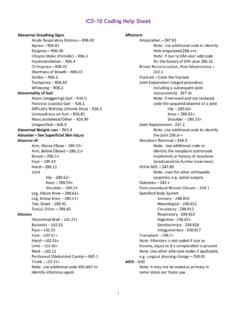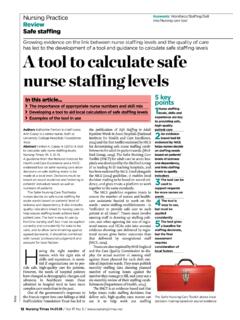Transcription of THE NHSN STANDARDIZED ANTIMICROBIAL …
1 THE NHSN STANDARDIZED ANTIMICROBIAL ADMINISTRATION RATIO (SAAR) A Guide to the SAAR Updated November 2020 The STANDARDIZED ANTIMICROBIAL Administration Ratio (SAAR) is a risk-adjusted summary measure of ANTIMICROBIAL use available to acute care hospitals participating in the National Healthcare Safety Network (NHSN) ANTIMICROBIAL Use (AU) Option. Hospitals can use the SAAR to track AU, compare their AU to a national benchmark, and assess the impact of interventions aimed at improving prescribing practices. As the NHSN AU Option grows, both in its user-base and surveillance capabilities, the SAAR evolves.
2 This document serves as guidance for users interested in understanding what the SAAR is, how NHSN develops SAARs, and how they can use the SAAR for antibiotic stewardship. 2 | Page Table of Contents Overview of the STANDARDIZED ANTIMICROBIAL Administration Ratio (SAAR) ..3 What is the SAAR? ..3 How does NHSN calculate the SAAR?..3 Why risk-adjust? ..3 Why not use stratified rates to make AU comparisons? ..4 SAAR Model Development ..4 Defining the referent population ..4 Defining SAAR ANTIMICROBIAL agent categories ..5 The SAAR predictive model development process ..6 SAARs in NHSN ..8 Finding and reading SAAR reports ..8 Interpreting the SAAR .. 10 Example SAAR interpretation.
3 11 Example SAAR calculation .. 12 Analysis Guidance and Using the SAAR for Action .. 16 Defining your benchmark .. 16 Comparing two SAAR values .. 17 Scalability of the SAAR how to aggregate SAAR data .. 18 Assessing AU data over time .. 20 Survey data and risk-adjustment .. 22 Using the SAAR for stewardship .. 23 Additional Resources .. 24 Appendix: SAAR Model Details .. 26 3 | Page Overview of the STANDARDIZED ANTIMICROBIAL Administration Ratio (SAAR) What is the SAAR? The STANDARDIZED ANTIMICROBIAL Administration Ratio (SAAR) is a summary measure of ANTIMICROBIAL use (AU) available to acute care hospitals participating in the AU Option of the National Healthcare Safety Network (NHSN) ANTIMICROBIAL Use and Resistance (AUR) Module.
4 NHSN or iginally developed the metric in 2015, using AU data reported in 2014, as a quantitative tool for hospitals and health systems to make comparisons of ANTIMICROBIAL use within and across facilities to help guide antibiotic stewardship efforts. The SAAR compares observed ANTIMICROBIAL days to predicted ANTIMICROBIAL days for groups of ANTIMICROBIAL agents used in specified patient care locations. A SAAR greater than indicates more ANTIMICROBIAL days were observed than predicted; conversely, a SAAR less than indicates fewer ANTIMICROBIAL days were observed than predicted. How does NHSN calculate the SAAR? NHSN calculates the SAAR by dividing the number of observed ANTIMICROBIAL days (also called ANTIMICROBIAL days of therapy [ DOT]) by the number of predicted ANTIMICROBIAL days.
5 NHSN calculates predicted ANTIMICROBIAL days by risk-adjusting for location- and facility-level factors found to be statistically significantly associated with differences in AU rates among the SAAR referent population. The referent population comes from nationally aggregated patient care location-level AU data reported to NHSN during the baseline time period. Observed AU: ANTIMICROBIAL days reported to the AU Option by a facility for a SAAR ANTIMICROBIAL agent category used in a specified patient care location or group of locations (SAAR-eligible locations). Predicted AU: ANTIMICROBIAL days predicted for that same ANTIMICROBIAL agent category used in the same location or group of locations.
6 NHSN calculates predicted ANTIMICROBIAL days using risk-adjusted SAAR predictive models. Why risk-adjust? A rate of ANTIMICROBIAL use, defined in the AU Option as ANTIMICROBIAL days divided by 1,000 days present, is the underlying metric on which SAARs are based. Many factors patient-level, location-level, facility-level may affect rates of AU in a given hospital or unit. To make fair comparisons of AU rates across entities, these factors must be considered (adjusted for). Unadjusted AU rates do not account for these differences and using them to make comparisons, may result in invalid conclusions. 4 | Page To make a fair comparison of AU across entities, we must know how the entities differ and whether any of those differences are associated with higher or lower AU rates.
7 There are many factors accounting for differences in AU across patient care locations and facilities, and ideally, we could take all predictive factors into consideration when developing NHSN metrics like the SAAR, but there is a trade-off between the added burden on hospitals to collect such data and the potential improvement gained in the models predictive abilities. At present, only patient care location type reported to the AU Option and select facility-level data reported to the NHSN Patient Safety Component Annual Hospital Survey are available for risk-adjustment in SAAR models. While illness severity and case-mix may affect a facility s AU rates, we must rely on location- and facility-level factors to serve as proxies for such factors because the AU Option does not collect patient-level information.
8 Why not use stratified rates to make AU comparisons? NHSN has the ability to calculate national pooled mean AU rates by dividing total pooled ANTIMICROBIAL days by total pooled days present and f acilities could use this national average rate to make comparisons; however, pooled rates do not reflect differences in risk between populations and, therefore, lose comparability over time and across entities. One solution is stratified rates, which are pooled mean rates calculated separately for different types of locations or facilities. This method, however, only allows for rate comparisons within strata. T he SAAR, on the other hand, allows users to summarize data by more than a single stratum by adjusting for AU rate differences among strata.
9 Additionally, SAARs allow for comparisons to the national benchmark from a baseline time period and hospitals can use them to measure progress from a single time point. In other words, standardization permits comparisons between ANTIMICROBIAL days experienced by a facility, group, or state to ANTIMICROBIAL days predicted based on national data. SAAR Model Development Defining the referent population A SAAR referent population, which NHSN uses to develop SAAR predictive models, is AU data aggregated from select patient care locations reporting to the AU Option for a particular year, specifically the baseline year.
10 NHSN assesses reporting volume for each location type to ensure sample size is large enough for inclusion in SAAR models. Associations between AU rates and risk factors identified in the referent population are later applied to the larger universe of SAAR-eligible locations and i f these associations were based on a small number of records, they may not be representative of all NHSN locations and facilities. The greater the sample size NHSN includes in SAAR predictive models, the more precise the SAAR estimates, or adjustments. SAAR referent populations include location types that are important to hospital antibiotic stewardship, have adequate reporting volume during the baseline year, and report for at least nine months of the baseline year.













